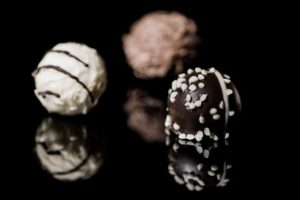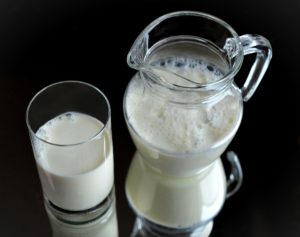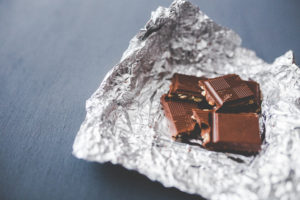Chocolate has earned the title “health food” in the last decade. But like wine, coconut butter, almond flour and so many foods in the health and fitness world that are celebrated for their nutritional benefits, how healthy is it really and how much should you eat?

Test your chocolate knowledge and find out what you know and what you need to know to make the best choices for your body.
01. All chocolate comes from cacao beans which after harvesting, are fermented for several days before being sent to plants for processing into chocolate.

TRUE
Cacoa beans are actually seeds from the fruit of a Theobroma Cacao tree. After picking, these seeds are allowed to ferment for 5-7 days and then dried and shipped for processing. The combination of drying, roasting and fermenting the seeds helps reduce the bitter flavanol levels. Artisan chocolatiers would say that fermentation may be one of the most critical steps because it helps develop the rich, buttery flavor and significantly meld the astringent tannins. Otherwise, chocolate just wouldn’t have it’s decadent appeal.
02. You must buy 80% or higher cocoa in order to get the health benefits of dark chocolate.

FALSE
Dark chocolate by definition is 70-99% cocoa solids. While it is true that the anti-inflammatory flavanols increase with the percentage of cocoa solids, so does the astringent or bitter flavor. Choose dark chocolate with at least 70% but don’t worry if you can’t handle 85% bitter-sweet chocolate.
White chocolate does NOT contain cocoa solids and only includes cocoa butter, sugar, milk solids and vanilla flavoring. Some brands don’t even contain cocoa butter- just vegetable oil and sugar!! Due to the lack of cocoa solids, white chocolate is void of the beneficial antioxidants. It also does not contain iron, magnesium, copper or zinc, as in it’s dark chocolate cousin.
03. Dark chocolate may improve blood flow and reduce blood pressure.

TRUE
Many studies have shown that chocolate and chocolate products may have a beneficial effect on blood pressure, similar to that of lifestyle changes like exercise. However, one 18-week study of hypertensive and pre-hypertensive individuals showed that as little as 30 calories of dark chocolate had a beneficial effect, lowering systolic BP (top number) by 3 points and diastolic BP by 2 points (bottom number).
04. Milk helps you absorb the antioxidants in chocolate.

FALSE
Milk and dairy actually bind to antioxidants in chocolate making them unavailable. Therefore, milk chocolate is not a good source of beneficial antioxidants.
05. Chocolate cravings indicate that your body needs nutrients within the chocolate.

MAYBE
The research is still unclear whether cravings indicate a physiological need or a psychological response. This means that it is possible that your body is desiring nutrients in the particular food OR it could be related to an emotional or mental attachment.
For example, when you are sick, you probably crave your mom’s famous chicken soup. Or, when you walk into your grandma’s house, you may crave her home-baked cookies. Or, when you walk into a movie theater, you may not be able to sit down until you have a tub of buttery popcorn in your hands.
Cravings can also be related to low blood sugars, when you are needing some energy. Your body may begin craving sugar, the quickest source of energy for a “pick-me-up”. It may have nothing to do with the beneficial nutrients in chocolate like iron, magnesium or copper. Instead, it may be the food you think of when your body wants an energy boost.
Don’t be deceived! Chocolate is not the bad guy but it is also not the answer.
- IF your body needs energy, you can choose a healthy snack like a piece of fruit and nuts (lots more snack ideas here)
- IF your body needs some iron, you can make a pot of chili (this is our favorite) with iron rich beans and beef and vitamin c from the tomatoes to help you absorb the iron even better.
- IF your body needs magnesium, you can get double (20%) in 1 ounce of almonds for the same calories as in chocolate.
- IF your body needs a dose of copper, include some copper rich foods into your usual diet like sunflower seeds, lentils and almonds.
If your mind can’t get chocolate off the brain, eat a small square and enjoy thoroughly.
06. Dark chocolate only complements red wine.

FALSE
While a rich red wine tends to be the ideal option for luscious dark chocolate, white wine is not an automatic fail. There are a few exceptions. Pairing wine and chocolate sounds romantically delicious, but there are a few guidelines to follow to make sure one doesn’t blow away the flavors of the other. Here is what you should consider:
- The sweetness and/or fruitiness of the wine needs to match that of the chocolate. If the chocolate is sweeter, the wine will seem dull or bitter.
- Pair based on the darkness of the chocolate. Look for intense, fruity reds (or whites) for darker chocolates.
- Experiment A LOT! Sometimes it takes some wrongs to end up at a right!
07. A dose of chocolate will give you a caffeine boost.

MAYBE…
…depends on your sensitivity to caffeine. If eating chocolate in small quantities of 1 ounce portions, it is unlikely that you will get the “boost” you are expecting. This portion only contains 23 mg caffeine which is one quarter of a typical 8oz cup of brewed coffee. If you do find that after eating chocolate you feel a surge of energy, it is likely due to the sugar.
08. Chocolate will put you in the mood…

UMM…
Well, the jury is still out as to whether chocolate is the aphrodisiac like the fanciful myths claim (you may have your own opinions!) but here is what we do know…
Chocolate can improve mood by boosting brain endorphins (natural opiates) and serotonin. There is a reason people reach for chocolate when they are in a bad mood! But no amount of chocolate will solve our problems or eliminate our stress, so make sure you don’t regret your chocolate splurge after the fact.
09. You should eat a little bit of dark chocolate every single day.

TRUE…
…At least according to the University of Michigan, Department of Integrative Medicine. Dark chocolate is included as a part of the Healing Foods Pyramid “as a part of a balanced, whole foods, plant-based diet. This Food Pyramid emphasizes foods that nourish the body, sustain energy over time, contain healing qualities and essential nutrients, and support a sustainable environment.”
They give 9 health benefits, although most of us would be satisfied with just 2 or 3. BUT, they do emphasize limiting to a 1 ounce portion. The key is making this treat fit into your eating pattern so that it is not adding more calories, sugar and fat than your body needs to maintain your goals.
So, if you needed a reason to eat it, wanted permission to take a bite, or were longing for a guilt-free pleasure, eat an ounce each day as a part of YOUR healthy diet.
TRUTH: And above all these put on love, which binds everything together in perfect harmony. –Colossians 3:14 (ESV)
REFERENCES
- Amano Artisan Chocolate
- USDA National Nutrient Database: Dark Chocolate
- Cornell University: Chocolate, Food of the Gods
- Today’s Dietitian: Mining the Riches of Dark Chocolate
EDITOR’S NOTE: The article was originally posted in February 2017 and updated in February 2019 for accuracy.
FREE 15 Fast Snacks that Won't Leave You Hungry

Tired of boring snacks? Want to know what to stock in your pantry and fridge to keep you fueled and satisfy cravings? Grab this yummy handout and sign up for my newsletter. Take one step today for your health!
